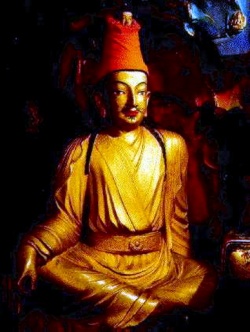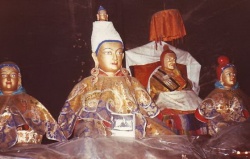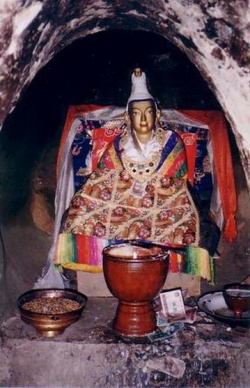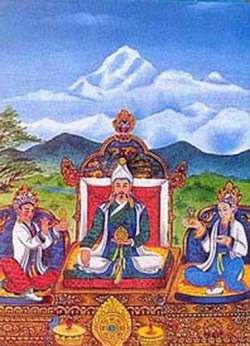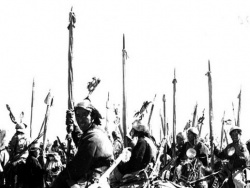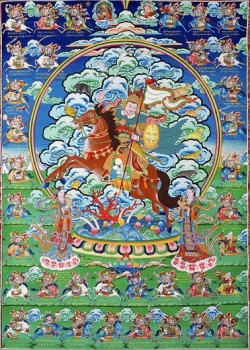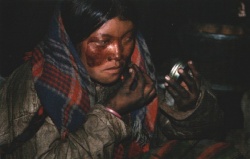Songtsän Gampo
Songtsän Gampo (Tibetan: Songtsän Gampo name.svg, Wylie: Srong-btsan sGam-po, 569–649?/605–649?) was the founder of the Tibetan Empire (Standard Tibetan: Bod; Chinese: 吐蕃; pinyin: Tǔbō/Tǔfán; Wade–Giles: T'u3-po1/T'u3-fan2), by tradition held to be the thirty-third ruler in his dynasty. In the Chinese records, his name is given as Songzan Ganbu (Sung-tsan Kan-pu; 松贊干布; pinyin: Sōngzàn Gānbù; Wade–Giles: Sung1-tsan4 Kan1-pu4) or Qizong Longzan (Chi-tsung Lung-tsan; 棄宗弄贊; pinyin: Qìzōng Lòngzàn; Wade–Giles: Ch'i4-tsung1 Lung4-tsan4).
His mother, the queen, is identified as 'Bri-bza' Thod-dkar-ma. The dates of his birth and when he took the throne are not certain. In Tibetan accounts, it is generally accepted that he was born in an ox-year, which means one of the following dates: 557, 569, 581, 583, 605 or 617 CE.) He is thought to have ascended the throne at age thirteen (twelve by Western reckoning), by this reckoning c. 629 CE.
There are difficulties with this position, however, and several earlier dates for the birth of Songtsän Gampo have been suggested, including 569, 593 or 605. The question must remain open.
Early life and cultural background
It is said that Songtsän Gampo was born at Gyama, in Maldro (a region to the northeast of modern Lhasa), the son of the Yarlung king Namri Songtsen. The book The Holder of the White Lotus says that it is believed that he was a manifestation of the Buddhist Bodhisattva Avalokiteshvara, of whom the Dalai Lama are similarly believed to be a manifestation of. His identification as a cakravartin or incarnation of Avalokiteśvara began in earnest in the indigenous Buddhist literary histories of the 11th. century.
Family
According to Tibetan tradition, Songstän Gampo was enthroned while still a minor as the thirty-third king of the Yarlung Dynasty after his father was poisoned circa 618. He is said to have been born in an unspecified Ox year and was 13 years old (12 by Western reckoning) when he took the throne. This accords with the tradition that the Yarlung kings took the throne when they were 13, and supposedly old enough to ride a horse and rule the kingdom. If these traditions are correct, he was probably born in the Ox year 605 CE. The Jiu Tangshu, or Book of Tang, notes that he "was still a minor when he succeeded to the throne.".
Songtsän Gampo's mother was, according to tradition, Dringma Togo of the Tsepong clan, which played an important part in the unification of Tibet. He also married Trimonyen Dongsten of the Mong clan, who is said to have been the mother of Gungsong Gungsten; and is said to have had several other wives: a noble woman from Minyak, the Nepali princess Bhrikuti Devi (whom many modern scholars are doubtful about), and a princess from Zhangzhung (while his sister, Princess Semarkar, married the king of Zhangzhung - which ultimately led to the conquest of Zhangzhung as described below), as well as the Chinese Princess Wencheng, or Munchang Kongcho .
Songtsän Gampo's heir, Gungsong Gungsten, died before his father, so his son, Manglon Mangsten, or Mangsong Mangtsen, took the throne. His mother is sometimes said to have been the Chinese princess, Munchang Koncho, but this is thought to be highly unlikely. His mother was most probably Mangmoje Trikar, who is mentioned in the Genealogy found in the "hidden library" in the caves in Dunhuang (which lists the names of the Tibetan emperors and the names of their consorts who bore future emperors, and the clans they came from).
Cultural activities
Songtsän Gampo is said to have sent his minister Thonmi Sambhota to India to devise a script for the Tibetan language, which led to the creation of the first Tibetan literary works and translations, court records and a constitution.
Songtsän Gampo moved the seat of his newly unified kingdom from the Yarlung Valley to Lhasa.
He is also credited with bringing many new cultural and technological advances to Tibet. The Jiu Tangshu, or Book of Tang, states that after the defeat in 648 of an Indian army in support of Chinese envoys, the Chinese Emperor, Gaozong, a devout Buddhist, gave him the title variously written Binwang, "Guest King" or Zongwang, "Cloth-tribute King" and 3,000 rolls of multicoloured silk in 649 and granted the Tibetan king's request for:
"... silkworms' eggs, mortars and presses for making wine, and workmen to manufacture paper and ink."
Traditional accounts say that, during the reign of Songtsän Gampo, examples of handicrafts and astrological systems were imported from China and Minyag; Dharma and the art of writing came from India; material wealth and treasures from the Nepalis and the lands of the Mongols, while model laws and administration were imported from the Uighurs to the North.
Introduction of Buddhism.
Songtsän Gampo is traditionally credited with being the first to bring Buddhism to the Tibetan people. He is also said to have built many Buddhist temples, including the Jokhang in Lhasa, the city in which he is credited in one tradition with founding and establishing as his capital, and Changzhug in Nêdong. During his reign, the translation of Buddhist texts from Sanskrit into Tibetan began.
Songtsän Gampo is considered to be the first of the three Dharma Kings (chosgyal) — Songtsän Gampo, Trisong Detsen, and Ralpacan — who established Buddhism in Tibet.
The inscription on the Skar-cung pillar (erected by Ralpacan, who ruled c. 800-815) reports that during Songtsän Gampo's reign, "shrines of the Three Jewels were established by building the temple of Ra-sa Lhasa and so on." The first edict of Trisong Detsen mentions a community of monks at this vihara.
620s
Songtsän Gampo was adept at diplomacy as well as on the field of battle. The king's minister, Myang Mang-po-rje, with the aid of troops from Zhang Zhung, defeated the Sumpa (Chinese: Supi) people in north-eastern Tibet circa 627 (Old Tibetan Annals l. 2).
Songtsän Gampo is traditionally said to have married the Nepalese princess Bhrikuti Devi (which, if true, probably took place sometime before 624). Although the story of this marriage is legendary, it is widely believed by Tibetans and some scholars acknowledge "it is quite likely to have taken place."
630s
Six years later (c. 632/633), Myang Mang-po-rje Zhang-shang was accused of treason and executed (OTA l. 4-5, Richardson 1965). Minister Mgar-srong-rtsan succeeded him.
The Jiu Tangshu records that the first ever embassy from Tibet arrived in China from Songtsän Gampo in the 8th Zhenguan year, or 634 CE. Tang dynasty chronicles describe this as a tribute mission, but it brought an ultimatum demanding a marriage alliance, not subservient rituals. After this demand was refused, Tibet launched victorious military attacks against Tang affiliates in 637 and 638.
The conquest of Zhang Zhung.
There is some confusion as to whether Central Tibet conquered Zhang Zhung during the reign of Songtsän Gampo or in the reign of Trisong Detsän (r. 755 until 797 or 804 CE). The records of the Tang Annals do, however, seem to place these events clearly in the reign of Songtsän Gampo, for they say that in 634, Yangtong (Zhang Zhung) and various Qiang tribes "altogether submitted to him." Following this, he united with the country of Yangtong to defeat the 'Azha, or Tuyuhun, and then conquered two more tribes of Qiang before threatening Songzhou with an army of (according to the Chinese) more than 200,000 men (100,000 according to Tibetan sources). He then sent an envoy with gifts of gold and silk to the Chinese emperor to ask for a Chinese princess in marriage and, when refused, attacked Songzhou. According to the Tang annals, he finally retreated and apologised, and, later, the emperor granted his request, but the histories written in Tibet all say that the Tibetan army defeated the Chinese and that the Tang emperor delivered a bride under threat of force.
Early Tibetan accounts say that the Tibetan king and the king of Zhang Zhung had married each other's sisters in a political alliance. However, the Tibetan wife of the king of the Zhang Zhung complained of poor treatment by the king's principal wife. War ensued, and, through the treachery of the Tibetan princess, "King Ligmikya of Zhangzhung, while on his way to Sum-ba (Amdo province) was ambushed and killed by King Srongtsen Gampo's soldiers. As a consequence, The Zhangzhung kingdom was annexed to Bod [[[Wikipedia:Central Tibet|Central Tibet]]]. Thereafter the new kingdom born of the unification of Zhangzhung and Bod was known as Bod rGyal-khab." R. A. Stein places the conquest of Zhang Zhung in 645.
Further campaigns
He next attacked and defeated the Dangxian, or "Western Xia" people (who later formed the Tangut state in 942 CE), the Bailan, and other Qiang tribes. The Bailan people were bounded on the east by the Tanguts and on the west by the Domi. They had been subject to the Chinese since 624.
After a successful campaign against China in the frontier province of Songzhou in 635–36 (OTA l. 607), the Chinese emperor agreed to send a Chinese princess for Songtsän Gampo to marry.
Circa 639, after Songtsän Gampo had a dispute with his younger brother Tsänsong (Brtsan-srong), the younger brother was burnt to death by his own minister Khäsreg (Mkha’s sregs) (possibly at the behest of his older brother, the emperor).
640s
The Jiu Tangshu records that when the king of 泥婆羅, Nipoluo ("Nepal"), the father of Licchavi king Naling Deva (or Narendradeva), died, an uncle, Yu.sna kug.ti, Vishnagupta) usurped the throne. "The Tibetans gave him refuge and reestablished him on his throne [in 641]; that is how he became subject to Tibet."
Sometime later, but still within the Zhenguan period (627-650 CE), the Tibetans sent an envoy to present day Nepal, where the king received him "joyfully", and, later, when a Tibetan mission was attacked in present-day India by then minister of emperor Harshavardhan who had usurped the throne after emperor Harshavardhan's death around 647 AD, the Licchavi king came to their aid.
The Chinese Princess Wencheng, niece of the Emperor Taizong of Tang China, left China in 640 to marry Songtsän Gampo, arriving the next year. Peace between China and Tibet prevailed for the remainder of Songtsän Gampo's reign.
Both wives are considered to have been incarnations of Tara (Standard Tibetan: Drolma), the Goddess of Compassion, the female aspect of Chenrezig:
"Dolma, or Drolma (Sanskrit Tara). The two wives of Emperor Srong-btsan gambo are worshipped under this name. The Chinese princess is called Dol-kar, of 'the white Dolma,' and the Nepalese princess Dol-jang, or 'the green Dolma.' The latter is prayed to by women for fecundity."
The Jiu Tangshu adds that Songtsän Gampo thereupon built a city for the Chinese princess, and a palace for her within its walls.
"As the princess disliked their custom of painting their faces red, Lungstan (Songtsän Gampo) ordered his people to put a stop to the practice, and it was no longer done. He also discarded his felt and skins, put on brocade and silk, and gradually copied Chinese civilization. He also sent the children of his chiefs and rich men to request admittance into the national school to be taught the classics, and invited learned scholars from China to compose his official reports to the emperor."
However, according to Tibetologist John Powers, such accounts of Tibet embracing Chinese culture through Wencheng are not corroborated by Tibetan histories.
Songtsän Gampo's sister Sad-mar-kar was sent to marry Lig-myi-rhya, the king of Zhang-zhung. However, when the king refused to consummate the marriage, she then helped Songtsän Gampo to defeat Lig myi-rhya and incorporate the Zhang-zhung of Western Tibet into the Tibetan Empire in 645, thus gaining control of most, if not all, of the Tibetan plateau.
Following the visit by the famous Chinese pilgrim monk Xuanzang to the court of Harsha, the king ruling Magadha, Harsha sent a mission to China which, in turn, responded by sending an embassy consisting of Li Yibiao and Wang Xuance, who probably travelled through Tibet and whose journey is commemorated in inscriptions at Rajagrha - modern Rajgir – and Bodhgaya.
Wang Xuanze made a second journey in 648, but he was badly treated by Harsha's usurper, his minister Arjuna, and Harsha's mission plundered. This elicited a response from Tibetan and Nepalese (Licchavi) troops who, together, soundly defeated Arjuna's forces.
In 649, the King of Xihai Jun was conferred upon Songtsen Gampo by Tang Gaozong, the emperor of the Tang Dynasty.
According to the Tibetan Annals, Songtsän Gampo must have died in 649, and, in 650, the Tang emperor sent an envoy with a "letter of mourning and condolences". His tomb is in the Chongyas Valley near Yalung.
Songtsän Gampo was succeeded by his infant grandson Mangsong Mangtsen, or Khri-mang-slon-rtsan, 650-676 CE. Real power was left in the hands of the minister Mgar-srong-rtsan. After this point, the dates in Tibetan history become somewhat firmer.
Songtsän Gampo's family and wives
Some Dunhuang documents say that, as well as his sister Sad-mar-kar (or Sa-tha-ma-kar), Songtsän Gampo had a younger brother who was betrayed and died in a fire, sometime after 641. Apparently, according to one partially damaged scroll from Dunhuang, there was hostility between Sa-tha-ma-kar and Songtsän Gampo's younger brother, bTzan-srong, who, as a result, was forced to settle in gNyal (an old district to the southeast of Yarlung and across the 5,090 metre (16,700 ft) Yartö Tra Pass, which bordered on modern Bhutan and Arunachal Pradesh in India). Little, if anything, else is known about this brother.
Songtsän Gampo is said to have had five wives. Nepalese princess Khri b'Tsun, or "Royal Lady" (Bhrikuti Devi), and the Chinese Princess Wencheng, both devout Buddhists, are the best known, but he also married daughters of the King of Zhang-zhung and the King of Minyak, as well as one each from the Ruyong and Mong (or Mang) clans (although other lists exist).
Songtsän Gampo's only son, Gungsrong Gungtsen (Gung-srong gung-btsan), was born to Mangza Tricham (Mang bza' Khri lcham or Mang bza' Khri-mo-mnyen lDong-steng), Princess of Mang, from Tolung (sTod lung), a valley to the west of Lhasa.
Some accounts say that when Gungsrong Gungtsen reached the age of thirteen (twelve by Western reckoning), his father, Songtsän Gampo, retired, and he ruled for five years (which could have been the period when Songtsän Gampo was working on the new constitution). Gungsrong Gungtsen is also said to have married 'A-zha Mang-mo-rje when he was thirteen, and they had a son, Mangsong Mangtsen (r. 650-676 CE). Gungsrong Gungtsen is said to have only ruled for five years when he died at eighteen. His father, Songtsän Gampo, took the throne again. Gungsrong Gungtsen is said to have been buried at Donkhorda, the site of the royal tombs, to the left of the tomb of his grandfather Namri Songtsen (gNam-ri Srong-btsan). The dates for these events are very unclear.
Songtsän Gampo was succeeded by his grandson, Mangsong Mangtsen, probably in 650 CE.
